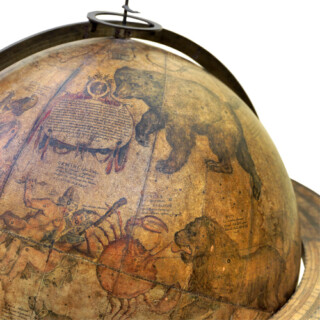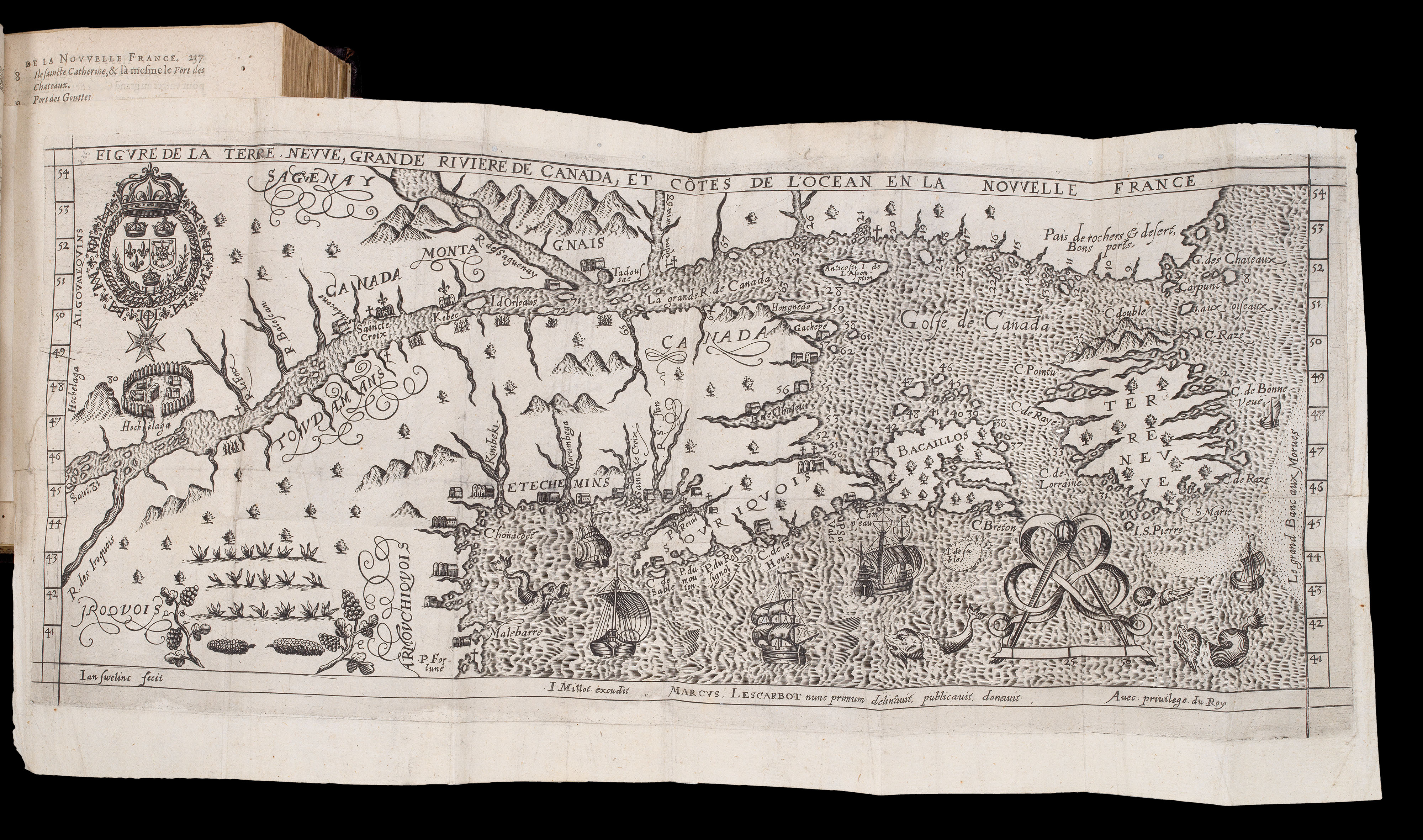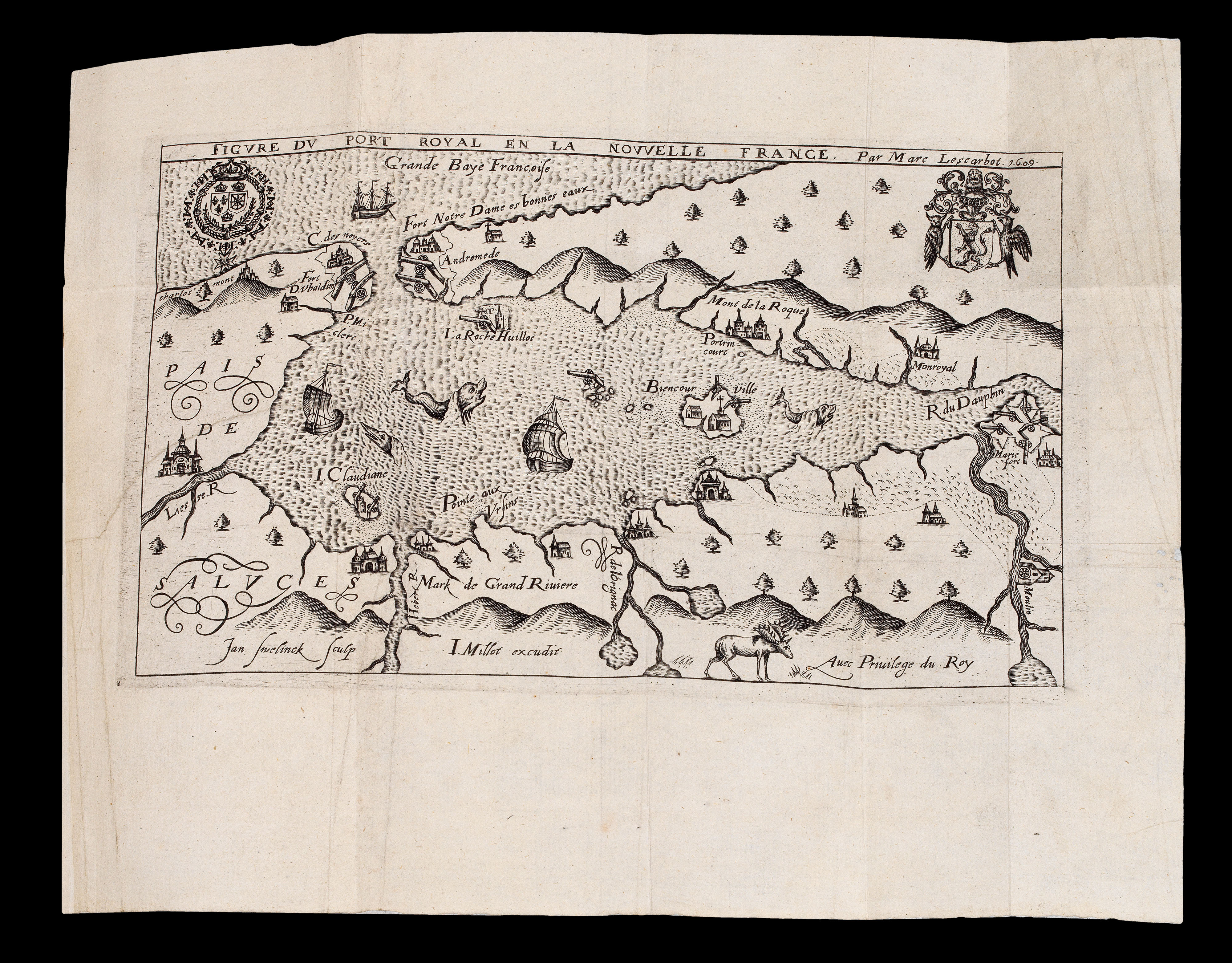First edition of the first published history of the French settlements in America. With the rare map 'Figvre de la terre nevve, grand riviere de Canada, et cotes de l'ocean en la Novvelle France', which is the "first detailed map devoted to Canada and by far the most accurate available at the time. Pre-dating the more familiar Champlain map by three years" (Burden).
The map, of '... la Nouvvelle France...', here in the first state, "extends up the St. Lawrence...
First edition of the first published history of the French settlements in America. With the rare map 'Figvre de la terre nevve, grand riviere de Canada, et cotes de l'ocean en la Novvelle France', which is the "first detailed map devoted to Canada and by far the most accurate available at the time. Pre-dating the more familiar Champlain map by three years" (Burden).
The map, of '... la Nouvvelle France...', here in the first state, "extends up the St. Lawrence River as far as the Indian Village 'Hochelaga', or Montreal as we now know it. The first trading post in Canada, founded in 1600 at 'Tadousac', is shown at the mouth of the 'R. de Saguenay' and just next to that is the River 'Lesquemin' mistakenly named in reverse. 'Kebec' is shown here for the first time on a printed map in its Micmac form, meaning the narrows of the river. On 13 May 1604 Pierre du Gua de Monts, leading a group of settlers, landed at 'P. du mouton', on the coast of Nova Scotia. With him was Samuel Champlain, the famous explorer who came from the same region in France as de Monts. Although there were of differing religious persuasions they were good friends. They eventually built a settlement on an Island on Passamaquoddy Bay called 'Saincte Croix'. In 1605 and again in 1606, Champlain sailed along the New England coast, past the land of the 'Etechemins' Indians, or Micmacs as they are more commonly known. He went as far as 'Malebarre' or Nauset Harbor on the coast of Cape Cod. 'P.Fortune' is Stage harbor. Later in 1605 the small outpost of Sainte Crox was moved to Port Royal where it was to remain until finally abandoned in 1613. During the second New England voyage, Marc Lescarbot was left in charge of the Port Royal colony" (Burden).
Port Royal is the subject of the second map, 'Figvre dv Port Royal en la Novvelle France', here in the first state. "First visited by Samuel de Champlain and Pierre du Gua de Monts in 1604, the Port Royal settlment was encouraged by Jean de Biencourt de Poutrincourt, who fell in love with the site during the same voyage. It was not until the summer of 1605, however, that they abandonned their initial site of Sainte Croix in favour of Port Royal. Marc Lescarbot, disenchanted with French life, arrived at the new colony of Port Royal in the summer of 1606. He immediately became one of the leaders and at one point, when Champlain was away exploring with Poutrincourt, was left in charge of the fledgeling colony. Upon their return he put on a play, the first in North America, to welcome them home" (Burden). This appears in 'Les Muses', the second part of the current work. A collection of poems and a masque, 'Le Theatre de Neptune en la Nouvelle France', is a kind of "nautical spectacle, organized to celebrate Poutrincourt's return to Port- Royal. The god Neptune comes in a bark to bid the traveller welcome; he is surrounded by a court of Tritons and Indigenous people, who recite in turn, in French, Gascon, and Souriquois verse, the praises of the leaders of the colony, and then sing in chorus to the glory of the king while trumpets sound and cannon are fired. This performance, given on 14 Nov. 1606 in the impressive setting of the Port-Royal basin, was the first theatrical presentation in the French language in North America" (Baudry).
The first part of the work is divided into three "books", the first of which is the 'Histoire', a compilation of accounts of the voyages of Verrazano, Laudonniere, Gourgues, and Villegagnon; the second book contains the voyages of Cartier, Roberval, De Monts, Poutrincourt, and the first voyages of Champlain; and the third book gives a description of the manners and customs of the local native tribes. In his work Lescarbot "did not confine himself to narration, but expressed many personal ideas. He had very precise opinions about the colonies, which he saw as a field of action for men of courage, an outlet for trade, a social benefit, and a means for the mother country to extend her influence. He favoured a commercial monopoly as a way to meet the expenses of colonization; for him, freedom of trade led only to anarchy, and produced nothing stable" (Baudry).
The Author
Marc Lescarbot (1570-1641) received a thorough classical and modern education in Paris, before turning to canonical and civil law. Thereafter he "took a minor part in the negotiations for the Treaty of Vervins made between Spain and France... He usually lived in Paris, where he associated with men of letters, such as the scholars Frédéric and Claude Morel, his first printers, and the poet Guillaume Colletet, who wrote a biography of him that has unfortunately been lost. He was likewise interested in medicine,... but he also travelled and maintained contact with his native region [of Guise], where he had relatives and friends, such as the Laroque brothers, his rivals in poetry, and where he recruited a number of clients. Because of one judge's venality he lost a case, which gave him a temporary distaste for the bar. Consequently, when one of his clients, Jean de Biencourt de Poutrincourt, who was associated with the Canadian enterprises of the Sieur Dugua de Monts, proposed that he accompany them on a voyage to Acadia, Lescarbot lost no time in accepting. He composed an 'Adieu à la France' in verse, and embarked at La Rochelle on 13 May 1606. He reached Port-Royal (Annapolis Royal, N.S.) in July, spent the remainder of the year there, and the following spring made a trip to the Saint John River and the Île Sainte-Croix. But in the summer of 1607 the revocation of de Monts's licence obliged all the colony's residents to go back to France. On his return there, Lescarbot published an epic poem on 'La défaite des sauvages armouchiquois' (1607), and then undertook to compose a vast history of the French establishments in America, the 'Histoire de la Nouvelle-France' [as here]. The first edition of this work appeared in Paris in 1609, published by the bookseller Jean Millot. The author first described the voyages of Laudonnière, Ribaut, and Gourgues to Florida, those of Durand de Villegaignon and Jean de Léry to Brazil, and then those of Verrazzano, Cartier, and Roberval to Canada. This last part, the least original of his work, is little more than a second-hand compilation.
He next undertook to recount de Monts's ventures in Acadia, and this part of his book is clearly original. He had spent a year at the Port- Royal habitation and met the survivors of the short-lived settlement at Sainte-Croix; he had talked with the promoters and members of the earlier voyages, François Gravé Du Pont, de Monts, and Champlain; and he had visited old fishing captains, who knew Newfoundland and the Acadian coasts. He therefore reported what he had himself seen or learned from those who had taken part in the events or witnessed them at first hand...
Lescarbot devoted the entire last part of his Histoire to a description of Indigenous people, in whom he was keenly interested. He frequently visited the Souriquois (Micmac, or Mi'kmaw) chiefs and warriors, observed their customs, made a collection of their remarks, and noted down their chants. In many respects he judged them to be more civilized and virtuous than Europeans, but, like a good Frenchman, he pitied them for their ignorance of the pleasures of wine and love" (Baudry).
Lescarbot, "a very picturesque figure, has a special place among the chroniclers of New France. Between Champlain, the somewhat unpolished man of action, and the missionaries concerned with evangelization, this lawyer-poet appears as a scholar and a humanist, a disciple of Ronsard and Montaigne. He possessed the intellectual curiosity, the taste for learning, and the Graeco-Latin culture of the Renaissance. Although a Roman Catholic, he maintained friendships with Protestants, and preserved in religious matters an attitude of independent judgement and of free inquiry that caused him to be considered unorthodox. By all these traits of character, he was a faithful reflection of his period, and showed himself a worthy subject of King Henri IV, whom he venerated.
His abundant and varied literary production is evidence of his intelligence and of the range of his talents. Apart from the works already mentioned, we know that he wrote some manuscript notes and some miscellaneous poems. In addition, he probably composed several pamphlets, published anonymously or left in manuscript, including a 'Traité de la polygamie', of which he himself spoke. He was also a musician, a calligrapher, and a draftsman, and Canadian folklorists can claim him as their precursor since he was the first to record the notation of Indigenous songs" (Baudry).
Rarity
Exceptionally rare: available records show only two other complete copies of this work have appeared at auction since this example was offered at the Streeter sale in 1966.











